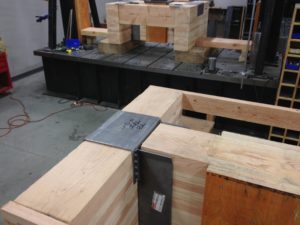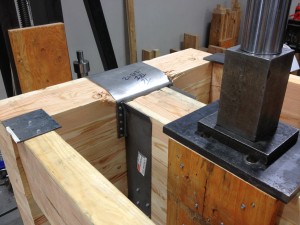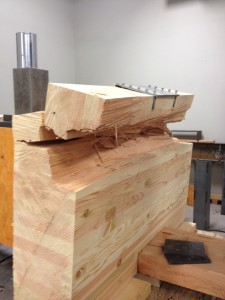With all of the frenzy that happens before (and during) the holidays, I won’t be doing full blog posts this or next week. But, I did want to remind you that this Thursday (12/20) is the last day to enter our “Creative Uses of Our Product” contest. We’ll post our five winners to the blog next week.
This week will be a short snapshot into what we were doing yesterday. We are always testing products and usually the only people who stop by to watch the tests besides the lab technicians are an R&D engineer and occasionally the product manager. As valuable as testing is, the simple day-to-day stuff just doesn’t generate much excitement – crushing bowling balls is fun and gets a crowd, but we save that for orientation classes.
Yesterday we drew a crowd of engineers interested in seeing just how high the load on the Simpson Strong-Tie® HGLS9 hanger could get with Strong-Drive® SDS screws. This was to compare with the allowable loads we have with the standard N54A (¼”x2½ long) nails that are currently used with this connector. A challenge in hanger tests that require a safety factor of 3 is preventing certain wood failures. To limit perpendicular to grain crushing of the joist at the point of applied load, we add wood or steel side plates to the beam and use a wide steel bearing plate to spread the load out. In this case, you can see the LVL side members that were glued and screwed to the glu-lam and the bearing plates for applying the load.



And sometimes we still end up breaking the wood. While we achieved our target load, it is preferable to avoid these types of failures as they are not indicative of real world performance. The cracking sound it made was impressive, though.
Happy Holidays, and thank you for your continued participation in our Structural Engineering Blog. See you in the New Year!
– Paul
What are your thoughts? Visit the blog and leave a comment!




This white paper gives an overview on how performance testing practice should be integrated into your Agile Processes. The paper summarizes the key activities and best practices involved in performance testing.
You left out the punchline – how much force did it take to cause failure?